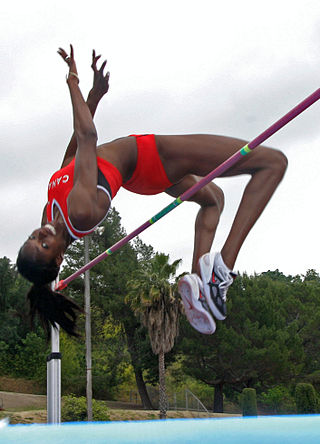
The high jump is a track and field event in which competitors must jump unaided over a horizontal bar placed at measured heights without dislodging it. In its modern, most-practiced format, a bar is placed between two standards with a crash mat for landing. Since ancient times, competitors have introduced increasingly effective techniques to arrive at the current form, and the current universally preferred method is the Fosbury Flop, in which athletes run towards the bar and leap head first with their back to the bar.

Valeriy Nikolayevich Brumel was a Russian high jumper. The 1964 Olympic champion and multiple world record holder, he is regarded as one of the greatest athletes ever to compete in the high jump. His international career was ended by a motorcycle crash in 1965.
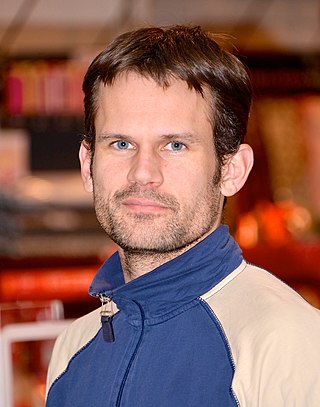
The men's high jump competition at the 2004 Summer Olympics in Athens was held at the Olympic Stadium on 20–22 August. Thirty-eight athletes from 27 nations competed. The event was won by Stefan Holm of Sweden, the nation's first victory in the men's high jump and first medal in the event since Patrik Sjöberg won three in a row from 1984 to 1992. Matt Hemingway took silver, returning the United States to the podium after a one-Games absence. Jaroslav Bába's bronze was the first medal in the event for the Czech Republic.
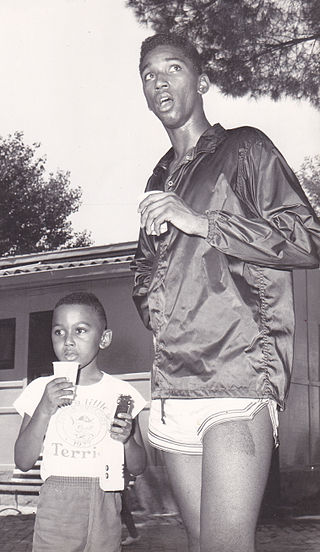
John Curtis Thomas was an American track and field athlete who set several world records in the high jump using the straddle technique. As a youth, he earned the Eagle Scout award. At the age of 17, while a freshman at Boston University, Thomas became the first man to clear 7 feet indoors. He subsequently pushed the world indoor record to 7'1½", and broke the world outdoor record three times, with a career best jump of 7'3¾" in 1960, at the age of 19.

The men's long jump was one of four men's jumping events on the Athletics at the 1964 Summer Olympics program in Tokyo. It was held on 18 October 1964. 37 athletes from 23 nations entered, with 5 not starting in the qualification round. The maximum number of athletes per nation had been set at 3 since the 1930 Olympic Congress. The event was won by Lynn Davies of Great Britain, breaking a string of eight straight American victories. It was Great Britain's first gold medal in the men's long jump, and first medal since 1900. It was only the second time the United States had not won the event, with Sweden's William Petersson in 1920 the only non-American to win before Davies. Ralph Boston of the United States and Igor Ter-Ovanesyan of the Soviet Union became the third and fourth men to win a second medal in the long jump.
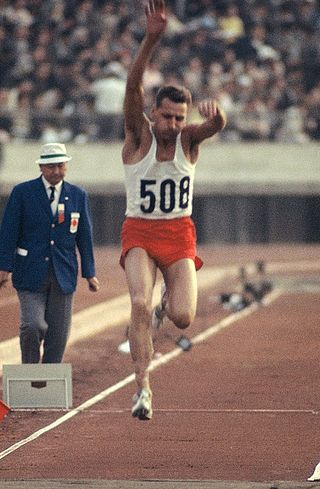
The men's triple jump was one of four men's jumping events on the Athletics at the 1964 Summer Olympics program in Tokyo. It was held on 16 October 1964. 36 athletes from 23 nations entered, with 2 not starting in the qualification round. The maximum number of athletes per nation had been set at 3 since the 1930 Olympic Congress. The event was won by Józef Szmidt of Poland, the third man to repeat as Olympic champion in the triple jump. Just as in 1960, the Soviet Union took silver and bronze behind Szmidt.
The men's high jump was an event at the 1996 Summer Olympics in Atlanta, Georgia. There were 38 competitors from 28 nations, with one non-starter. The maximum number of athletes per nation had been set at 3 since the 1930 Olympic Congress. The event was won by Charles Austin of the United States, the nation's first victory in the men's high jump since 1968 and 13th overall. Artur Partyka of Poland became the seventh man to win two medals in the event, following his 1992 bronze with silver in these Games. Steve Smith's bronze was Great Britain's first medal in the men's high jump since 1908.
The men's high jump was an event at the 1992 Summer Olympics in Barcelona, Spain. There were 43 participating athletes from 27 nations. The maximum number of athletes per nation had been set at 3 since the 1930 Olympic Congress. The qualification mark was set at 2.29 metres. The event was won by Javier Sotomayor of Cuba, the nation's first victory in the men's high jump. Patrik Sjöberg of Sweden earned silver, becoming the first man to win a third medal in the event, though he never won gold. Sweden was only the third country to have three consecutive podium appearances. A three-way tie for third could not be resolved by countback, so bronze medals were awarded to Tim Forsyth, Artur Partyka, and Hollis Conway.

The men's high jump event at the 1984 Summer Olympics in Los Angeles, California was held at the Los Angeles Memorial Coliseum on 10–11 August 1984. Thirty athletes from 20 nations competed. The maximum number of athletes per nation had been set at 3 since the 1930 Olympic Congress. The event was won by Dietmar Mögenburg of West Germany, the nation's first victory in the men's high jump. Patrik Sjöberg's silver was Sweden's first medal in the event since 1920. Zhu Jianhua won bronze in the People's Republic of China's first appearance. The United States, which had made the podium in each of the 18 editions of the high jump before the 1980 boycott, now missed the podium for the first time in which the country competed, as Dwight Stones in fourth place fell just short of becoming the first man to earn three medals in the event.

The men's high jump at the 2008 Olympic Games took place on 17–19 August at the Beijing Olympic Stadium. Forty athletes from 28 nations competed. The event was won by Andrey Silnov of Russia, the nation's second victory in the men's high jump. Germaine Mason's silver was Great Britain's first medal in the event since 1996, and matched the nation's best-ever result. Silnov's countryman Yaroslav Rybakov won bronze, marking the first time since 1988 that a nation had two medalists in the men's high jump in the same Games. Reigning world champion Donald Thomas, who cleared 2.32 metres at Osaka 2007, finished in twenty-first place and failed to advance into the final round. For the first time, no American made the final.

The men's high jump event at the 1980 Summer Olympics in Moscow, Soviet Union had an entry list of 30 competitors from 19 nations. The maximum number of athletes per nation had been set at 3 since the 1930 Olympic Congress. The final was held on Friday 1 August 1980. The event was won by Gerd Wessig of East Germany, the first gold medal by a German athlete in the men's high jump. It was also the first time a world record in the high jump had been set at the Olympics. Jörg Freimuth took bronze, making East Germany the third nation to have two medalists in the event in the same Games. Defending champion Jacek Wszoła of Poland took silver, becoming the fourth man to win two high jump medals and matching Valeriy Brumel for best results at one gold and one silver. Through the 2016 Games, Wszoła, Brumel, and Javier Sotomayor remain the most successful Olympic men's high jumpers; no high jumper has won two gold medals, or one gold and two silvers. Due at least in part to the American-led boycott, the United States' streak of making the podium in every Olympic men's high jump event to date ended, though a strong field may have kept them out of the medals even if they had competed.

The men's high jump event at the 2000 Summer Olympics as part of the athletics program was held at the Olympic Stadium on Friday, 22 September and Sunday, 24 September. Thirty-five athletes from 24 nations competed. The maximum number of athletes per nation had been set at 3 since the 1930 Olympic Congress. The high jump has been ever present since the beginning of the modern Olympic Games in 1896. The event was won by Sergey Klyugin of Russia, the nation's first medal and victory in the men's high jump in the nation's first appearance after the breakup of the Soviet Union. Javier Sotomayor of Cuba was the eighth man to win a second medal in the event ; he joined Valeriy Brumel and Jacek Wszoła as the most successful Olympic high jumpers in history with a gold and a silver—despite missing the 1984 and 1988 Games due to boycott and being hampered by injury in 1996. Abderrahmane Hammad's bronze was Algeria's first medal in the men's high jump.

The men's high jump event at the 1932 Olympic Games took place July 31. It was a final only format, no heats or qualifying jumps. Fourteen athletes from 10 nations competed. The 1930 Olympic Congress in Berlin had reduced the limit from 4 athletes per NOC to 3 athletes. The event was won by Duncan McNaughton of Canada, breaking the United States' dominance over the event; McNaughton was the first non-American to win. Bob Van Osdel of the United States took silver, while Simeon Toribio earned the Philippines' first medal in any track & field athletics event.

The men's high jump field event at the 1960 Olympic Games took place on September 1. Thirty-two athletes from 23 nations competed. The maximum number of athletes per nation had been set at 3 since the 1930 Olympic Congress. The event was won by Robert Shavlakadze of the Soviet Union, the nation's first victory in the men's high jump. Valery Brumel took silver; both men surpassed the previous best placing for the Soviet team of bronze. American John Thomas took bronze to keep alive the United States' streak of medaling in every edition of the Olympic men's high jump.
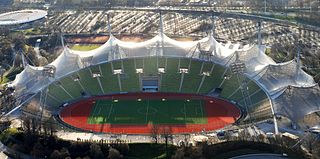
The men's long jump event at the 1972 Summer Olympics in Munich was held on 8 & 9 of September. Thirty-six athletes from 25 nations competed. The maximum number of athletes per nation had been set at 3 since the 1930 Olympic Congress. The event was won by Randy Williams of the United States, the nation's second consecutive and 15th overall gold medal in the men's long jump. Hans Baumgartner earned West Germany's first medal in the event.
The men's high jump field event at the 1972 Olympic Games took place on September 9 & 10. Forty athletes from 26 nations competed. The maximum number of athletes per nation had been set at 3 since the 1930 Olympic Congress. The event was won by Jüri Tarmak of the Soviet Union; he was the last man to win an Olympic gold medal using the straddle technique. The more popular and more widely used Fosbury Flop technique was the most common technique used.

The men's high jump at the 1952 Olympic Games took place on 20 July at the Helsinki Olympic Stadium. Thirty-six athletes from 24 nations competed. The maximum number of athletes per nation had been set at 3 since the 1930 Olympic Congress. American athlete Walt Davis won the gold medal and set a new Olympic record. It was the Americans' 10th victory in the men's high jump. José da Conceição won Brazil's first medal in the men's high jump, with bronze.

The men's high jump was one of four men's jumping events on the Athletics at the 1968 Summer Olympics program in Mexico City. Thirty-nine athletes from 25 nations competed. The maximum number of athletes per nation had been set at 3 since the 1930 Olympic Congress. Dick Fosbury won by using a backward jumping style that was called the Fosbury Flop. This was the unveiling of the new style on the world stage. The style completely revolutionized the sport. By the mid 1970s and ever since, virtually all of the top competitors were using the new style.

The men's high jump at the 1976 Summer Olympics took place on July 30 & 31. Thirty-seven athletes from 23 nations competed. The maximum number of athletes per nation had been set at 3 since the 1930 Olympic Congress. The event was won by Jacek Wszoła of Poland, breaking the US/USSR hold on the men's high jump title. It was Poland's first medal in the event. Greg Joy's silver was Canada's first medal in the event since 1932. Dwight Stones won his second consecutive bronze medal, becoming the third man to win multiple medals in the high jump and keeping the United States' streak of podium appearances alive one final time. The Soviet streak of five Games with podium appearances in the event ended.

The men's high jump competition at the 2016 Summer Olympics in Rio de Janeiro, Brazil was held at the Olympic Stadium between 14–16 August. Forty-four athletes from 28 nations competed. The event was won by Derek Drouin of Canada, the nation's first victory in the men's high jump since 1932. Drouin was the ninth man to win multiple medals in the high jump, after his 2012 bronze. Mutaz Essa Barshim, who had tied Drouin for bronze in 2012, was the tenth multiple medalist in the event. Barshim's silver was Qatar's fifth Olympic medal in any event, and the first better than bronze. Bohdan Bondarenko took bronze, Ukraine's first medal in the men's high jump.
















